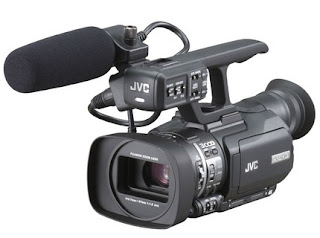In our lesson we got introduced to our cameras which we will be using to make our thriller openings. The JVC GY-HM100 is the smallest professional format camcorder available at about the size of a lens for a 2/3-inch imager camera. This makes it ideal for applications where a full size camera would be impractical, such as tight spaces and operating in potentially unsafe situations.
In order to keep the cameras safe and working, there are a few rules which must be followed.
- Always make sure the camera is in a safe place, e.g: in a bag, being held, and not on the floor, or on a bench where it could easily be broken or lost. Treat it like it's your own.
- Insert the right sim card, the right way.
- Never touch the veiwfinder or the lens as your fingerprints will remain.
- Return ALL equiptment back to staff when finished at the end time.
- Dont leave the camera on when it is not being used, and no filming in rain unless umbrella is over it.
We also have tripods to help us achieve our movies, they are necessary when slow-speed exposures are being made, or when telephoto lenses are used, as any camera movement while the shutter is open will produce a blurred image. What's more, they reduce camera shake, and so are ideal in achieving maximum sharpness. A tripod is also helpful in achieving precise framing of the image, or when more than one image is being made of the same scene.
Rules for tripods.
- In order for no shaky or unbalanced tripods, the legs must be fully extended and secured to whichever length you want, as they can be quite stiff.
- Don't leave out in the rain unless an umbrella is above it.
- Always pick up your tripod when moving it, no dragging it along the floor.


No comments:
Post a Comment